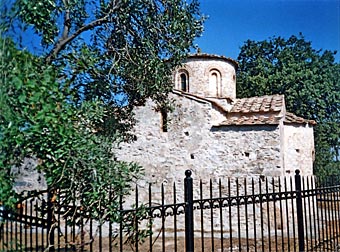Type: Cross-in-Square
Date: 10th century
Description:
In the east of Koropi, when we reach the end of Vasileos Konstantinou Street we continue straight towards Markopoulo. We turn to Hagios Panteleimon Street and road signs with the indication “Metamorphosis” lead us to the church, which lies only a few meters away. The church of Metamorphosis is one of the oldest Byzantine monuments of Attica. It is a cross-in-square church of the so-called “transitional” type dated to the second half of the 10th century. Inside the church the layer of wall paintings preserved is dated to the beginning of the 11th century. The second, more recent layer painted by Georgios Markos is dated to the 18th century. From the Byzantine layer, interesting is the Pantokrator representation in the dome, because it combines the subject of Pantokrator (usual after the Iconoclasm) with archaic iconographic elements dated to the early Christian period. In the dome center, Pantokrator is surrounded by seraphs and the Evangelists’ symbols in a huge clipeus, which is held by eight angels with raised hands. The representations in the apse also reflect the period after the Iconoclasm. Panagia Kiriotissa between two archangels is portrayed in the conch, while hierarchs facing each other are depicted in the cylindrical section. In the bema and the main church we can detect signs of evangelical scenes and figures of saints. This combination of archaic and contemporary iconographic elements as well as the linear attribution of the figures heralding 11th century trends date the layer of wall paintings towards the end of the 10th and the beginning of the 11th century. In the northern side of the church fragments of a posterior chapel are still visible, while closely in the southwest we notice fragments of an auxiliary building.
The cluster of churches in the area is impressive (Hagios Georgios, Hagioi Anargyroi, Hagios Theodoros or Modestos). Their density in combination with the scattered building fragments in the area and the established middle Byzantine phases suggest the existence of a small Byzantine settlement.
Panayotidi Maria, Les monuments de Grèce depuis la fin de la crise iconoclaste jusqu’ à l’ an mille, Paris 1969, σ. 131-140, πίν. 79, Skawran Karin, The Development of Middle Byzantine Fresco Painting in Greece, Pretoria 1982, p. 154-155, plan 45-49.














